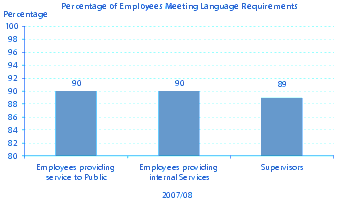Management of Personnel
|
Expectation (a): The Board must assure itself that the Agency has a human resources management regime that promotes Canada Revenue Agency values and ethics.
|
||
|---|---|---|
|
Related Key Questions
|
Evidence
|
Sources of Evidence
|
|
|
|
|
|
|
|
|
|
|
|
|
|
Management Performance Measures
|
|
|---|---|
 |
Is the
CRA
workforce guided by
CRA
values and ethics?
Management performance will be demonstrated by trending the results of public perceptions of the
RA regarding respect and professionalism as revealed in the annual corporate survey.
|
|
Rating Scale
|
Board’s Assessment and Related Comments
|
Next Steps
|
|---|---|---|
|
Strong
|
Strong
|
|
|
Acceptable
|
||
|
Opportunity for improvement
|
||
|
Attention required
|
|
Expectation (b): The Board must assure itself that the Agency has a human resources (HR) management regime, which both maintains a workforce that is productive and adaptable, and effectively manages employee performance through the use of best practices.
|
||
|---|---|---|
|
Related Key Questions
|
Evidence
|
Sources of Evidence
|
|
|
|
|
|
|
|
|
|
|
Management Performance Measures
|
|
|---|---|
 |
Does the Agency’s workforce meet ongoing and new business goals?
|
|
Management performance will be demonstrated by trending the results of the completion rates of employees and managers with performance expectations and assessments in place. (see chart)
|
|
|
|
|
|
|
|
Rating Scale
|
Board’s Assessment and Related Comments
|
Next Steps
|
|---|---|---|
|
Strong
|
Strong
|
|
|
Acceptable
|
||
|
Opportunity for improvement
|
||
|
Attention required
|
|
Expectation (c): The Board must assure itself that the Agency has a Human Resources management regime that is sustainable—recruits and retains the right talent.
|
||
|---|---|---|
|
Related Key Questions
|
Evidence
|
Sources of Evidence
|
|
|
|
|
|
|
|
Management Performance Measures
|
|---|
|
Does the
CRA workforce have a sustainable capacity to perform its duties (for example— its size, mix of skills, and diversity of backgrounds)?
Management performance will be demonstrated by trending the results of Agency retention rates by region and retention rates by major occupational group.
|
  |
|
Rating Scale
|
Board’s Assessment and Related Comments
|
Next Steps
|
|---|---|---|
|
Strong
|
Strong
|
|
|
Acceptable
|
||
|
Opportunity for improvement
|
||
|
Attention required
|
|
Expectation (d): The Board of Management must assure itself that the Agency has a Human Resources management regime that encourages continuous learning, improvement, and innovation.
|
||
|---|---|---|
|
Related Key Questions
|
Evidence
|
Sources of Evidence
|
|
|
|
|
|
|
|
Management Performance Measures
|
|---|
|
Is the
CRA workforce versatile, innovative, and continuously learning?
Management performance demonstrated by trending the results of Agency investment in learning as a percentage of payroll and average training days per employee. In 2007-2008, the
CRA invested approximately $161.5 million in learning (including language training) which represented 6% of
salary budget.
|
|
Rating Scale
|
Board’s Assessment and Related Comments
|
Next Steps
|
|---|---|---|
|
Strong
|
Strong
|
|
|
Acceptable
|
||
|
Opportunity for improvement
|
||
|
Attention required
|
|
Expectation (e): The Board must assure itself that the Agency has a Human Resource management regime which ensures that collective agreements are respected.
|
||
|---|---|---|
|
Related Key Questions
|
Evidence
|
Sources of Evidence
|
|
|
|
|
Management Performance Measures
|
|---|
|
Are employment and workplace practices fair and are labour relations effective?
|
|
Rating Scale
|
Board’s Assessment and Related Comments
|
Next Steps
|
|---|---|---|
|
Strong
|
Strong
|
|
|
Acceptable
|
||
|
Opportunity for improvement
|
||
|
Attention required
|
|
Expectation (f): The Board must assure itself that the Agency has a Human Resources management regime that adheres to applicable legislation.
|
||
|---|---|---|
|
Related Key Questions
|
Evidence
|
Sources of Evidence
|
|
|
|
|
|
|
|
|
|
|
Management Performance Measures
|
|---|
|
Does the workplace reflect appropriate official language balance?
Do employment equity (
EE
) representation rates for employees and executives match or exceed labour market availability?
Does the
CRA
adhere to safe workplace conditions according to the
Canada Labour Code
?
Management performance will be demonstrated by trending the results of the percentage of employment equity representation of self-identified employees (executive and non-executive levels) compared to their respective labour market availability.
|
  |
 |
|
Rating Scale
|
Board’s Assessment and Related Comments
|
Next Steps
|
|---|---|---|
|
Strong
|
Strong
|
|
|
Acceptable
|
||
|
Opportunity for improvement
|
||
|
Attention required
|